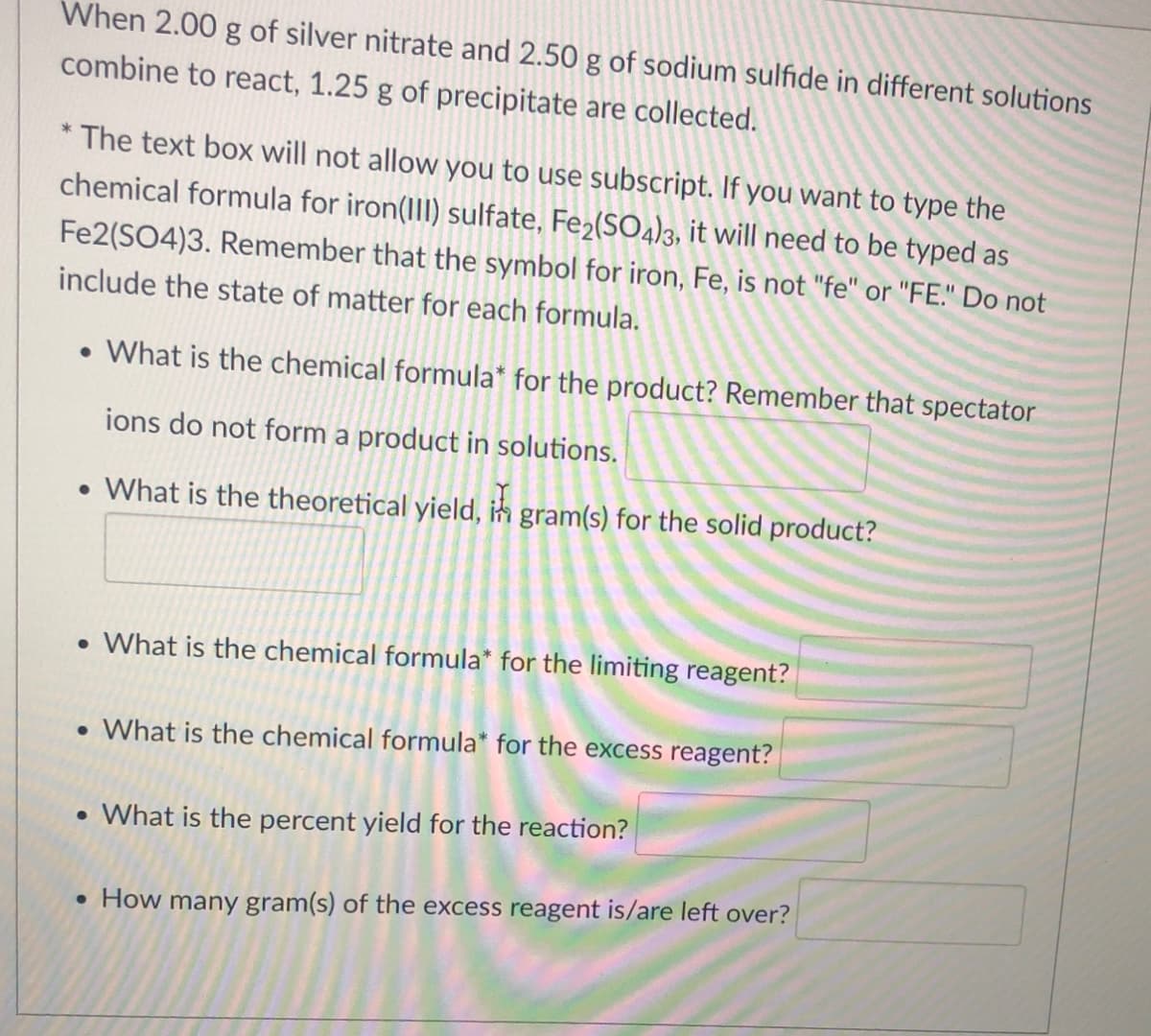When 2.00 g of silver nitrate and 2.50 g of sodium sulfıde in different solutions combine to react, 1.25 g of precipitate are collected. * The text box will not allow you to use subscript. If you want to type the chemical formula for iron(III) sulfate, Fe2(SO4)3, it will need to be typed as Fe2(SO4)3. Remember that the symbol for iron, Fe, is not "fe" or "FE." Do not include the state of matter for each formula. • What is the chemical formula* for the product? Remember that spectator ions do not form a product in solutions. What is the theoretical yield, in gram(s) for the solid product?
When 2.00 g of silver nitrate and 2.50 g of sodium sulfıde in different solutions combine to react, 1.25 g of precipitate are collected. * The text box will not allow you to use subscript. If you want to type the chemical formula for iron(III) sulfate, Fe2(SO4)3, it will need to be typed as Fe2(SO4)3. Remember that the symbol for iron, Fe, is not "fe" or "FE." Do not include the state of matter for each formula. • What is the chemical formula* for the product? Remember that spectator ions do not form a product in solutions. What is the theoretical yield, in gram(s) for the solid product?
Chemistry: The Molecular Science
5th Edition
ISBN:9781285199047
Author:John W. Moore, Conrad L. Stanitski
Publisher:John W. Moore, Conrad L. Stanitski
Chapter3: Chemical Reactions
Section: Chapter Questions
Problem 139QRT
Related questions
Question
Answer ASAP

Transcribed Image Text:When 2.00 g of silver nitrate and 2.50 g of sodium sulfide in different solutions
combine to react, 1.25 g of precipitate are collected.
* The text box will not allow you to use subscript. If you want to type the
chemical formula for iron(III) sulfate, Fe2(SO4)3, it will need to be typed as
Fe2(SO4)3. Remember that the symbol for iron, Fe, is not "fe" or "FE." Do not
include the state of matter for each formula.
• What is the chemical formula* for the product? Remember that spectator
ions do not form a product in solutions.
• What is the theoretical yield, in gram(s) for the solid product?
• What is the chemical formula* for the limiting reagent?
• What is the chemical formula* for the excess reagent?
• What is the percent yield for the reaction?
• How many gram(s) of the excess reagent is/are left over?
Expert Solution
This question has been solved!
Explore an expertly crafted, step-by-step solution for a thorough understanding of key concepts.
This is a popular solution!
Trending now
This is a popular solution!
Step by step
Solved in 2 steps with 2 images

Knowledge Booster
Learn more about
Need a deep-dive on the concept behind this application? Look no further. Learn more about this topic, chemistry and related others by exploring similar questions and additional content below.Recommended textbooks for you

Chemistry: The Molecular Science
Chemistry
ISBN:
9781285199047
Author:
John W. Moore, Conrad L. Stanitski
Publisher:
Cengage Learning

Chemistry
Chemistry
ISBN:
9781305957404
Author:
Steven S. Zumdahl, Susan A. Zumdahl, Donald J. DeCoste
Publisher:
Cengage Learning


Chemistry: The Molecular Science
Chemistry
ISBN:
9781285199047
Author:
John W. Moore, Conrad L. Stanitski
Publisher:
Cengage Learning

Chemistry
Chemistry
ISBN:
9781305957404
Author:
Steven S. Zumdahl, Susan A. Zumdahl, Donald J. DeCoste
Publisher:
Cengage Learning


Chemistry for Engineering Students
Chemistry
ISBN:
9781337398909
Author:
Lawrence S. Brown, Tom Holme
Publisher:
Cengage Learning

Introductory Chemistry: A Foundation
Chemistry
ISBN:
9781337399425
Author:
Steven S. Zumdahl, Donald J. DeCoste
Publisher:
Cengage Learning

Chemistry: An Atoms First Approach
Chemistry
ISBN:
9781305079243
Author:
Steven S. Zumdahl, Susan A. Zumdahl
Publisher:
Cengage Learning